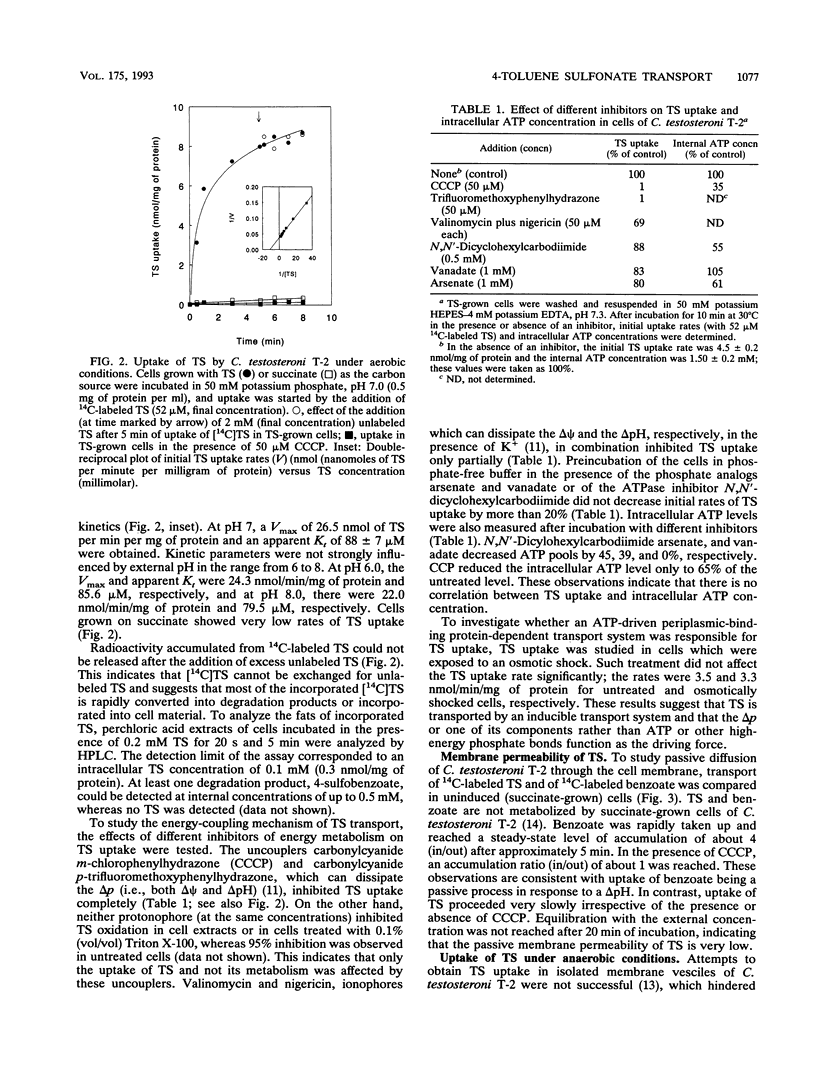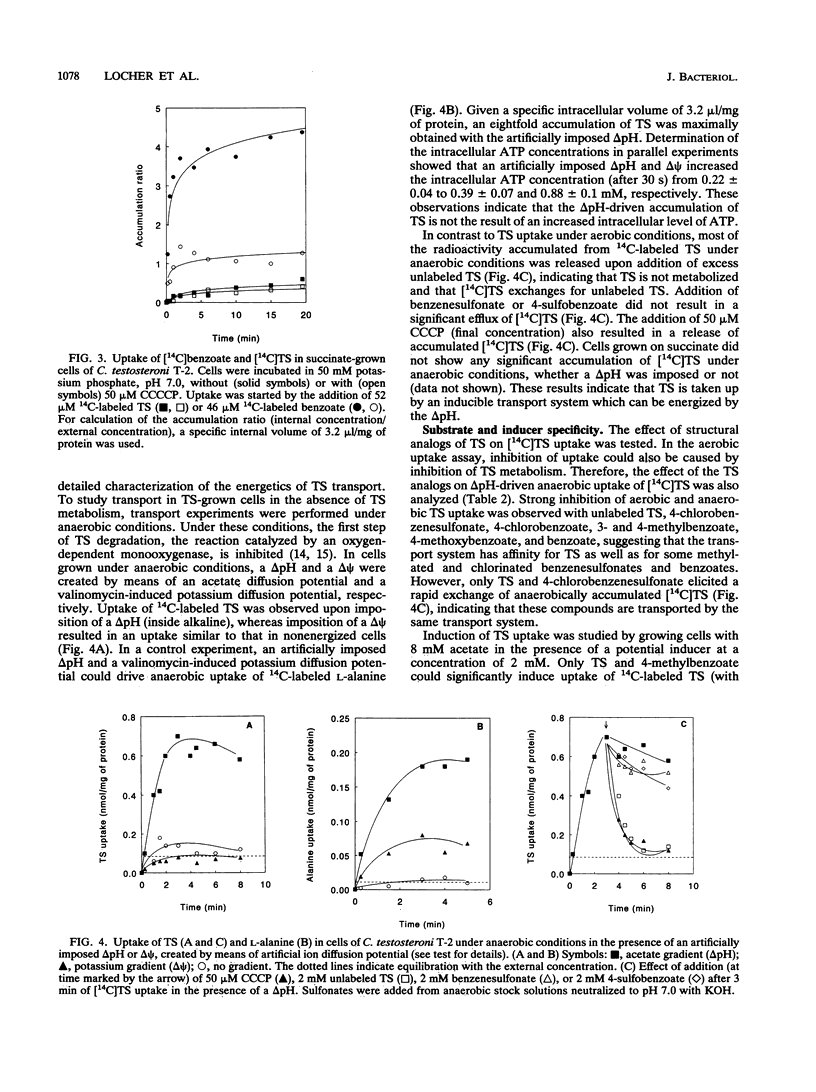Abstract
The mechanism of transport of the xenobiotic 4-toluene sulfonate (TS) in Comamonas testosteroni T-2 was investigated. Rapid uptake of TS was observed only in cells grown with TS or 4-methylbenzoate as a carbon and energy source. Initial uptake rates under aerobic conditions showed substrate saturation kinetics, with an apparent affinity constant (Kt) of 88 microM and a maximal velocity (Vmax) of 26.5 nmol/min/mg of protein. Uptake of TS was inhibited completely by uncouplers and only marginally by ATPase inhibitors and the phosphate analogs arsenate and vanadate. TS uptake was also studied under anaerobic conditions, which prevented intracellular TS metabolism. TS was accumulated under anaerobic conditions in TS-grown cells upon imposition of an artificial transmembrane pH gradient (delta pH, inside alkaline). Uptake of TS was inhibited by structurally related methylated and chlorinated benzenesulfonates and benzoates. The results provide evidence that the first step in the degradation of TS by C. testosteroni T-2 is uptake by an inducible secondary proton symport system.
Full text
PDF





Selected References
These references are in PubMed. This may not be the complete list of references from this article.
- Brilon C., Beckmann W., Hellwig M., Knackmuss H. J. Enrichment and isolation of naphthalenesulfonic Acid-utilizing pseudomonads. Appl Environ Microbiol. 1981 Jul;42(1):39–43. doi: 10.1128/aem.42.1.39-43.1981. [DOI] [PMC free article] [PubMed] [Google Scholar]
- Cook A. M., Fewson C. A. Evidence for specific transport mechanisms for aromatic compounds in bacterium N.C.I.B. 8250. Biochim Biophys Acta. 1972 Dec 1;290(1):384–388. doi: 10.1016/0005-2736(72)90081-8. [DOI] [PubMed] [Google Scholar]
- Groenewegen P. E., Driessen A. J., Konings W. N., de Bont J. A. Energy-dependent uptake of 4-chlorobenzoate in the coryneform bacterium NTB-1. J Bacteriol. 1990 Jan;172(1):419–423. doi: 10.1128/jb.172.1.419-423.1990. [DOI] [PMC free article] [PubMed] [Google Scholar]
- Harwood C. S., Gibson J. Uptake of benzoate by Rhodopseudomonas palustris grown anaerobically in light. J Bacteriol. 1986 Feb;165(2):504–509. doi: 10.1128/jb.165.2.504-509.1986. [DOI] [PMC free article] [PubMed] [Google Scholar]
- Hegeman G. D. Synthesis of the enzymes of the mandelate pathway by Pseudomonas putida. II. Isolation and properties of blocked mutants. J Bacteriol. 1966 Mar;91(3):1155–1160. doi: 10.1128/jb.91.3.1155-1160.1966. [DOI] [PMC free article] [PubMed] [Google Scholar]
- Higgins S. J., Mandelstam J. Evidence for induced synthesis of an active transport factor for mandelate in Pseudomonas putida. Biochem J. 1972 Feb;126(4):917–922. doi: 10.1042/bj1260917. [DOI] [PMC free article] [PubMed] [Google Scholar]
- Hurwitz C., Braun C. B., Peabody R. A. Washing bacteria by centrifugation through a water-immiscible layer of silicones. J Bacteriol. 1965 Dec;90(6):1692–1695. doi: 10.1128/jb.90.6.1692-1695.1965. [DOI] [PMC free article] [PubMed] [Google Scholar]
- Kihara M., Macnab R. M. Cytoplasmic pH mediates pH taxis and weak-acid repellent taxis of bacteria. J Bacteriol. 1981 Mar;145(3):1209–1221. doi: 10.1128/jb.145.3.1209-1221.1981. [DOI] [PMC free article] [PubMed] [Google Scholar]
- LOWRY O. H., ROSEBROUGH N. J., FARR A. L., RANDALL R. J. Protein measurement with the Folin phenol reagent. J Biol Chem. 1951 Nov;193(1):265–275. [PubMed] [Google Scholar]
- Leidner H., Gloor R., Wüest D., Wuhrmann K. The influence of the sulphonic group on the biodegradability of n-alkylbenzene sulphonates. Xenobiotica. 1980 Jan;10(1):47–56. doi: 10.3109/00498258009033730. [DOI] [PubMed] [Google Scholar]
- Locher H. H., Leisinger T., Cook A. M. 4-Toluene sulfonate methyl-monooxygenase from Comamonas testosteroni T-2: purification and some properties of the oxygenase component. J Bacteriol. 1991 Jun;173(12):3741–3748. doi: 10.1128/jb.173.12.3741-3748.1991. [DOI] [PMC free article] [PubMed] [Google Scholar]
- Locher H. H., Leisinger T., Cook A. M. Degradation of p-toluenesulphonic acid via sidechain oxidation, desulphonation and meta ring cleavage in Pseudomonas (Comamonas) testosteroni T-2. J Gen Microbiol. 1989 Jul;135(7):1969–1978. doi: 10.1099/00221287-135-7-1969. [DOI] [PubMed] [Google Scholar]
- Neu H. C., Heppel L. A. The release of enzymes from Escherichia coli by osmotic shock and during the formation of spheroplasts. J Biol Chem. 1965 Sep;240(9):3685–3692. [PubMed] [Google Scholar]
- Newton G. L., Aguilera J. A., Fahey R. C., Ward J. F., Radkowsky A. E., Kosower E. M. para-sulfobenzoyloxybromobimane: a new membrane-impermeable reagent useful for the analysis of thiols and their export from cells. Anal Biochem. 1992 Feb 14;201(1):30–42. doi: 10.1016/0003-2697(92)90170-c. [DOI] [PubMed] [Google Scholar]
- Poolman B., Smid E. J., Konings W. N. Kinetic properties of a phosphate-bond-driven glutamate-glutamine transport system in Streptococcus lactis and Streptococcus cremoris. J Bacteriol. 1987 Jun;169(6):2755–2761. doi: 10.1128/jb.169.6.2755-2761.1987. [DOI] [PMC free article] [PubMed] [Google Scholar]
- Poolman B., Smid E. J., Veldkamp H., Konings W. N. Bioenergetic consequences of lactose starvation for continuously cultured Streptococcus cremoris. J Bacteriol. 1987 Apr;169(4):1460–1468. doi: 10.1128/jb.169.4.1460-1468.1987. [DOI] [PMC free article] [PubMed] [Google Scholar]
- Thayer J. R., Wheelis M. L. Active transport of benzoate in Pseudomonas putida. J Gen Microbiol. 1982 Aug;128(8):1749–1753. doi: 10.1099/00221287-128-8-1749. [DOI] [PubMed] [Google Scholar]
- Thurnheer T., Zürrer D., Höglinger O., Leisinger T., Cook A. M. Initial steps in the degradation of benzene sulfonic acid, 4-toluene sulfonic acids, and orthanilic acid in Alcaligenes sp. strain O-1. Biodegradation. 1990;1(1):55–64. doi: 10.1007/BF00117051. [DOI] [PubMed] [Google Scholar]


